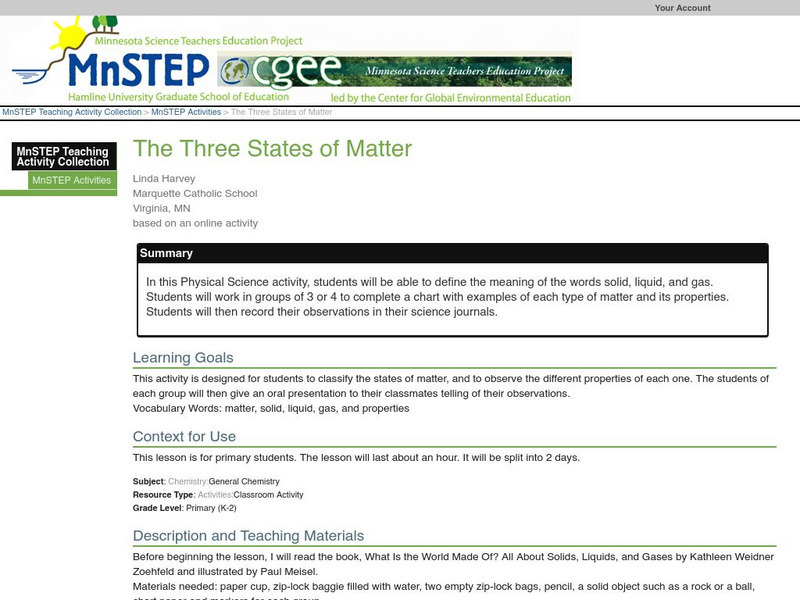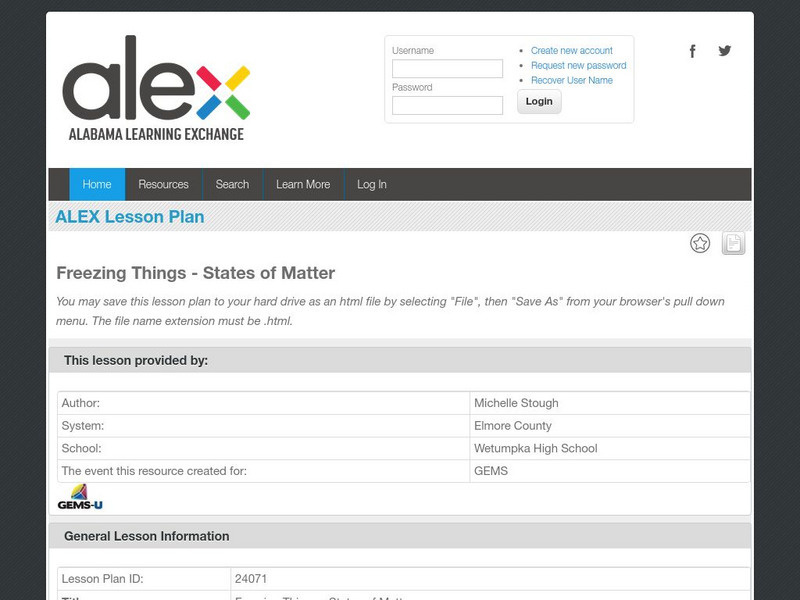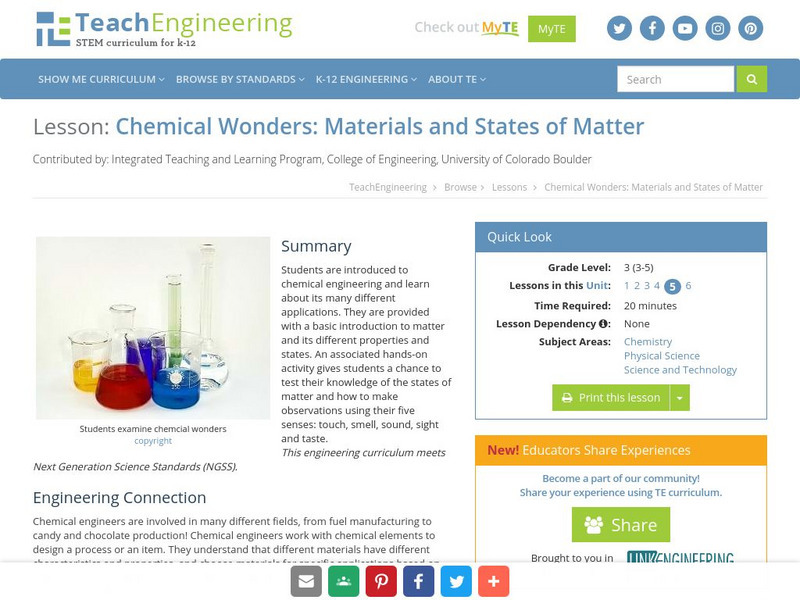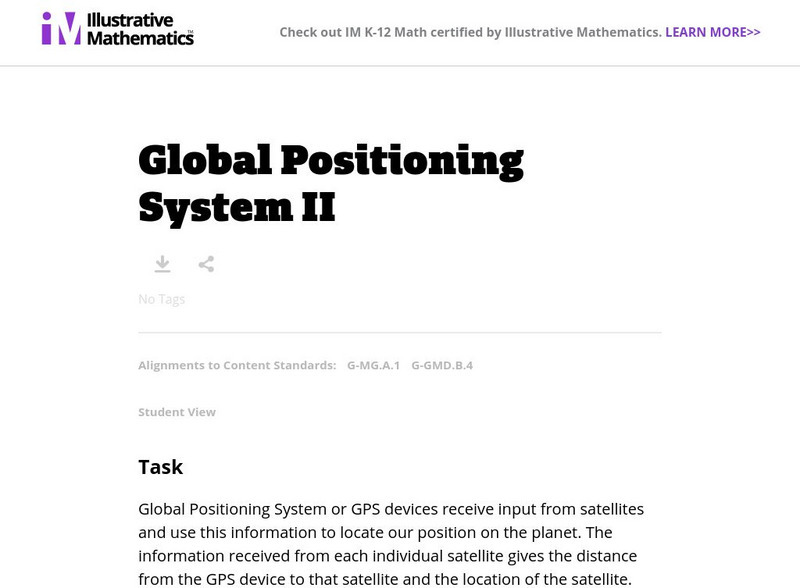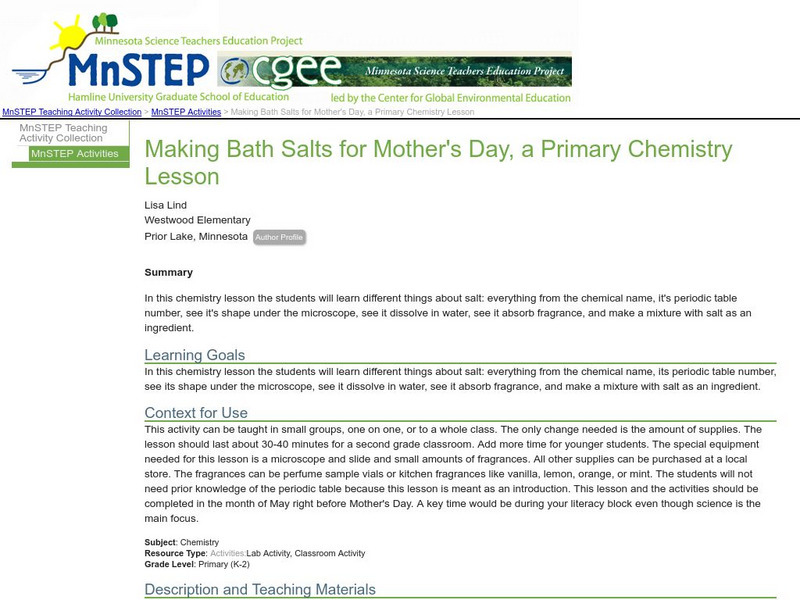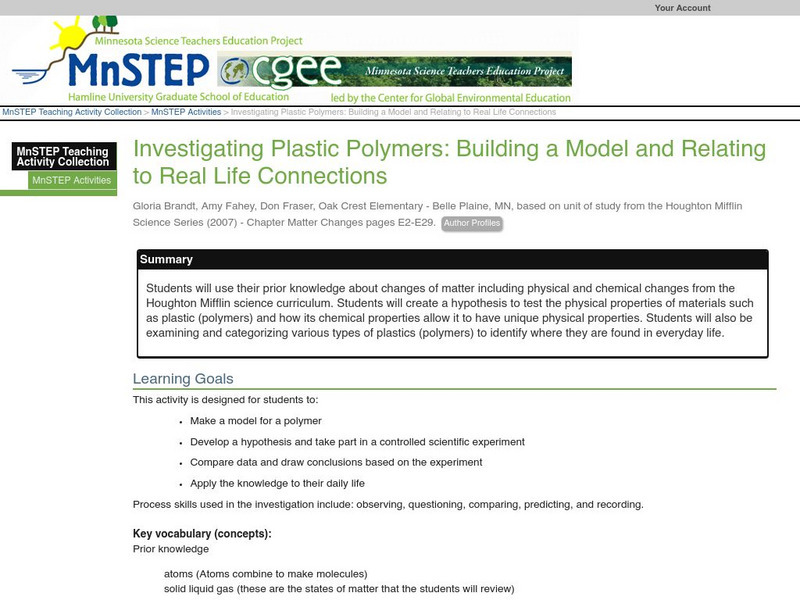Curated OER
Calculating the Average Mass of the Newly Discovered Element: Bean
Learners determine the average mass of a new element using masses from three isotopes. In this chemistry lesson, students explain what an isotope is. They discuss their importance and uses.
Curated OER
Temperature and Altitude
Young scholars, after reading the explanation given below, use FoilSim to gather and record data on temperature and altitude generated by the FoilSim control panel.
Utah Education Network
Uen: Matter, It Does!
In this activity students identify forms and changes of matter.
Science Education Resource Center at Carleton College
Serc: The Three States of Matter
In this Physical Science exploration activity, students explore the meaning of the words solid, liquid, and gas. Student groups complete a chart with examples of each type of matter and its properties and then record their observations...
Alabama Learning Exchange
Alex: Freezing Things: States of Matter
The class will go back over the Power Point presentation on chemical and physical properties. The teacher will then conduct numerous liquid nitrogen demos. This lesson is used early in the Chemistry course. The students love it. This...
Science Education Resource Center at Carleton College
Serc: Mystery Material: Is It a Solid or a Liquid?
Is it a solid or a liquid? In this activity, students will handle a mystery substance that has qualities of both a solid and a liquid while learning about phases. They will manipulate the substance, record any observations they...
TeachEngineering
Teach Engineering: Chemical Wonders
Students are introduced to chemical engineering and learn about its many different applications. They are provided with a basic introduction to matter and its different properties and states. An associated hands-on activity gives...
Science Education Resource Center at Carleton College
Serc: Mystery Material
Middle schoolers will investigate an unknown material by determining its properties and categorizing its state of matter. They will observe how it behaves under different conditions, record their observations, analyze information, and be...
Council for Economic Education
Econ Ed Link: The Mystery of Is It Mine or Ours? (Educator Version)
Did you ride to school on a road today? Yesterday did you skate in a public park? Maybe Mom or Dad traveled home from one of your ball games on their bicycles under a string of street lights? How did the road, the park or the street...
Science Education Resource Center at Carleton College
Serc: Air Is Matter
It's difficult at times for younger young scholars to realize that air has mass. Matter is something that has volume (takes up space) and has mass (*can be weighed). Air does take up space, even if we can't see it, and air has weight,...
Alabama Learning Exchange
Alex: How Sweet It Is
As part of the study of Matter, the young scholars will determine the density of standard percent sugar solutions through hands on experimentation. In laboratory groups, students will graph a standardized curve of the experimental data....
US National Archives
Docsteach: The Titanic Disaster: Measuring Loss of Life, Property and Injuries
Students will analyze claims filed by survivors, families of victims and owners of cargo of the Titanic disaster. They will examine claims for loss of life, loss of property and injuries that were filed as part of 'In the Matter of the...
American Chemical Society
Middle School Chemistry: What Is Density?
Calculate the density of cubes made of different materials to determine what type of material it contains. Using this information explain that the size, mass, and arrangement of the atoms or molecules of a substance determines its density.
American Chemical Society
Middle School Chemistry: Density: Sink and Float for Solids
Students determine whether an object will sink or float by comparing its density to the density of water.
Science Education Resource Center at Carleton College
Serc: Plastic Polymers: Investigating Their Flexibility
Young scholars will use their prior knowledge about changes of matter to develop a hypothesis to test the physical properties of materials such as plastic (polymers) and how its chemical properties allow it to have unique physical...
Illustrative Mathematics
Illustrative Mathematics: G Mg, G Gmd Global Positioning System Ii
Satellites communicate with a GPS device and establish the distance between them and their locations. The set of points at a fixed distance from a satellite form a sphere so when the GPS receives its distance from a given satellite, this...
Science Education Resource Center at Carleton College
Serc: Making Bath Salts for Mother's Day, a Primary Chemistry Lesson
What do you know about salt? In this chemistry instructional activity, students will learn different things about salt: the chemical name, it's periodic table number, it's shape under the microscope, how it dissolves in water, and how to...
Science Education Resource Center at Carleton College
Serc: Investigating Plastic Polymers: Building a Model
Young scholars will use their prior knowledge about changes of matter including physical and chemical changes from the Houghton Mifflin science curriculum. Students will create a hypothesis to test the physical properties of materials...
University of Texas at Austin
The University of Texas Mc Donald Observatory: Spectroscope
This lesson guides students to build a spectroscope, use it as a tool, and interpret their observations by applying concepts of conservation of energy and properties of matter.



